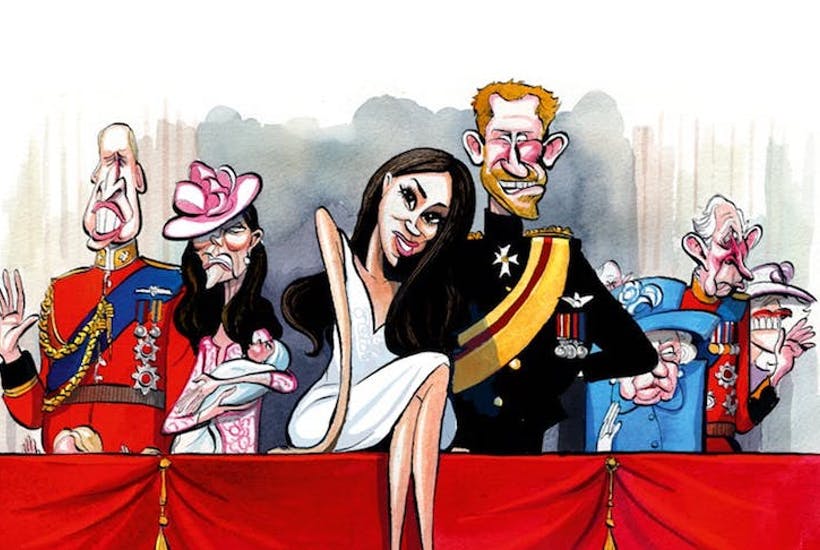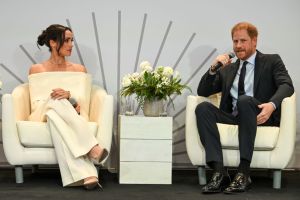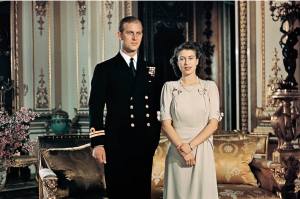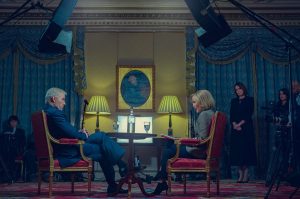What will become of the British monarchy after Elizabeth II? It’s a question that many would prefer not to ask. But the Queen is ninety-five, her husband died earlier this year and she’s pulling out of engagements she’s rarely missed in sixty-nine years on the throne. More honest royal sources confirm the obvious: she’s had to take another significant step away from public life. From now on she will conduct more duties over video calls. She’ll save her energies for key events such as the Christmas broadcast.
Which leads us to the thorny matter of her succession. Queen Elizabeth has managed to sustain the prestige and influence of the crown in an obsessively democratic age. Will her heir, Prince Charles, and his sons be able to replicate that remarkable achievement? Recent years suggest that the answer might be no. We all know the grubby allegations about Prince Andrew. We’ve also watching another tabloid drama with an American subplot unfold: the House of Cambridge vs the House of Sussex, Kate and Wills vs Hazza and Megz, “brothers at war,” etc.
To sustain interest — or engagement (buzzword) — a modern monarchy must offer some soap operatic elements. At least that’s what Palace PR wizards believe. But the clash between the younger royals threatens to turn the whole Windsor show into reality TV, a ghastly clash between drama-queen princes and their feuding wives. It’s titillating stuff, no doubt. It’s also vulgar, which is dangerous for an institution that is meant to be the opposite. At some point people grow bored and turn off.
The chief problem is that Harry and Meghan appear to have been driven mad by fame — an unfortunate twist given their efforts to publicize mental-health issues. Last week, Prince Harry revealed that he, a postmodern Cassandra, had warned Twitter’s founder Jack Dorsey that “his platform was allowing a coup to be staged” ahead of the January 6 riot in DC. As a “commissioner” for the Aspen Institute on “Information Disorder,” Harry is trying to establish himself as a great enemy of fake news. This week, on the Sussexes’ official Archewell website, he published fifteen rules to which the media should adhere. The timing was perfectly ridiculous, since just five days earlier his wife had been forced to admit that she had misled a British court in the Sussexes privacy case against the Mail on Sunday.
Harry and Meghan’s great folly is to have convinced themselves that they can be supreme masters of their image. Last week, their former spokesman Jason Knauf sensationally revealed how heavily involved the couple have been in crafting their own PR. Texts between Meghan and Knauf showed her saying she’d addressed her father as “Daddy” so that “in the unfortunate event” that it leaked she would “pull on the heartstrings.” She also said that everything she drafted was written “with the understanding that it could be leaked.”
Knauf is due to leave royal employment next month to live in India. Yet his parting shot at Harry and Meghan is highly revealing. He left the Sussexes to work for the Cambridges and closely assisted Kate and William in their roles at the Royal Foundation. “It seems extremely unlikely that he would not have at least let Catherine and William know about his upcoming testimony,” says a well-placed source. “If they wanted to stop him disclosing Palace communications, they could surely have done so.”
Before the initial hearing against the Mail on Sunday, Knauf and the three other press aides to Harry and Meghan — the so-called “Palace Four” — stayed quiet. After the judge ruled against the newspaper in February, however, Knauf decided he could no longer keep schtum. A month after the judgment, on March 2, it emerged that he’d filed bullying complaints against the Duchess. He also changed lawyers.
On March 7, that big Oprah interview came out, in which Meghan accused the Palace aides of being complicit in a reactionary plot to silence her truth. “They were willing to lie to protect other members of the family,” she said. “They were not willing to tell the truth to protect me and my husband.”
Knauf is gay, progressive, woke even. It must have infuriated him and other aides to watch their former employers, riddled with self-pity, describing how they were so mistreated by a fusty and racist old institution. The truth is that the “Palace Four” went to enormous lengths to promote the “Fab Four” — William, Kate, Harry and Meghan — before the two households fell out in 2019. There was excited talk about the younger royals becoming a “philanthropic powerhouse.” But the Four weren’t so Fab. In fact, they couldn’t stand each other.
Even after the Oprah interview, Palace operators have tried to engineer a rapprochement between the brothers. Various occasions presented themselves, notably the funeral of Prince Philip in April and the unveiling of the Diana statue in July. But sources say that Harry showed little enthusiasm to do more than the bare minimum of showing up.
Poor Harry has been lost to La La Land. Through Archewell, he and Meghan are running a new, hyperactive publicity operation on the other side of the Atlantic. It’s monarchy with American characteristics. Last week, for instance, they didn’t mark Remembrance Day; they attended Veterans Day events in New Jersey and New York. It all makes useful content, no doubt, for the fly-on-the-wall documentary they are bringing out as part of their £112 million ($151 million) deal with Netflix. There’s also the $20 million, tell-all book deal with Random House.
All the cringe-inducing hoopla around Harry and Meghan is beneficial to William and Kate, in a creepy PR way. Once the “reluctant royal,” William now emerges as the dutiful and diligent future king. The newspapers took particular delight in the images of Kate in her modest black Remembrance Sunday dress, a contrast to Meghan and her low-cut poppy-colored number. You don’t have to be a fashion expert to spot the difference. Moreover, a shared hostility towards the troublesome pair in America has brought William closer to his father and the new press team representing Charles and Camilla at Clarence House.
Charles, who may soon be king, has long wanted to streamline “the Firm” — and limit the possibilities for embarrassment by shrinking the number of serving royals. He probably didn’t imagine that would include cutting out one son in order to promote another. Harry, for his part, could never have dreamed a few years ago that he would be antagonizing his family by running a trashy spin-off operation from Beverly Hills.
The recent episodes of the real-life Crown seem rather sad and cruel. But nobody said that monarchy was meant to be fair.
This article was originally published in The Spectator’s UK magazine. Subscribe to the World edition here.


















